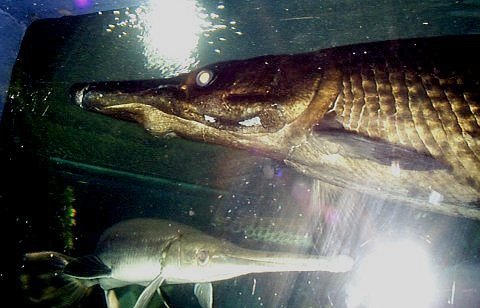 |
 |
| Name: Alligator Gar |
| Scientific name: Lepisosteus spatula |
| Range: Gulf of Mexico coastal plain from Florida to Vera Cruz, Mexico |
| Habitat: Slow sluggish waters |
| Status: Threatened |
| Diet in the wild: Fish, waterfowl, turtles and small animals |
| Diet in the zoo: Carnivorous diet |
| Location in the zoo: James R. Record Aquarium |
| Physical description: An adult alligator gar can reach lengths of up to eight feet and can weigh in excess of 302 pounds. It has a long and slender body which is covered in bony scales. Its anal and dorsal fins are located rearward and are nearly opposite of each other. It has a long snout which consists of two rows of sharp teeth, making it easy to tell it apart from the other gars. Its colors range from brown to olive on the top portion of its body, to lighter colors on the underside. |
| General information: Lepisosteus is a Greek term meaning "bony scale", and spatula is the Latin word for "spoon". The most noticable part of the gars body is the elongated snout. This menacing looking fixture contains two rows of teeth which are used in shredding their victims. Its prime source for food is catfish if available; if not they are not shy of chomping down on almost anything. This fish is often referred to as a "trash fish", because of its choice of brackish water and its willingness to try to eat just about anything. The alligator gar, however, is a dominant species in its habitat, for no other creature can tackle its size. |
| Special anatomical, physiological or behavioral adaptations: An alligator gar's buoyancy bladder is connected directly to its throat, giving it the ability to breathe air above the surface of the water. Because of this benefit, the gar has a dangerous habit of basking near the surface. This is a danger because of the ease in which bowhunters can catch this interesting fish. |
| Personal Observations: I have had some experience with this fish, for I have caught a few myself (the smaller ones of course). One of these even had part of a license plate and a sliver of a soda can caught in its jaws, setting an example of this animal's sharp bite and willingness to eat, or at least attempt to eat, just about anything. As evil as they might look at first sight though, they are quite fascinating to watch. They will sit near the surface for long periods of time giving the viewer a chance to see the entire animal. |
| Source Materials and Related Links:
U.S. Fish & Wildlife Service World Book Encyclopedia Fort Worth Zoo |
| Page author: Paul Stover
E-mail:redstover@yahoo.com |
WhoZoo Home Animal Index Fish Index |